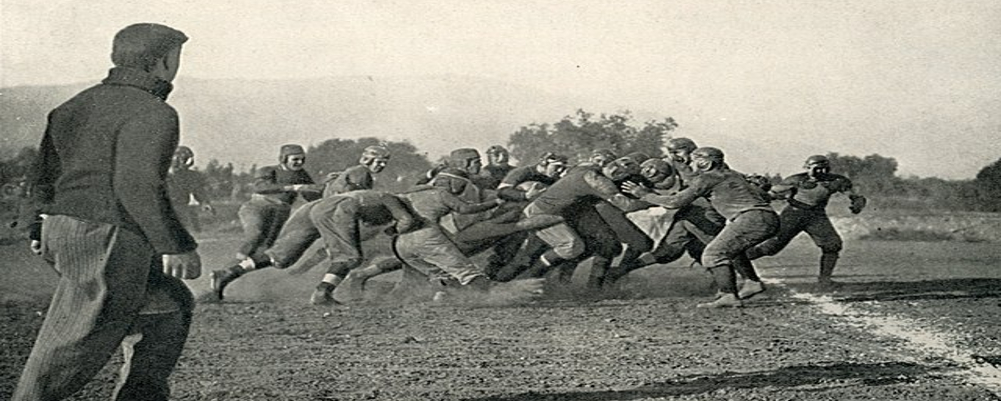This conversation is based on Tim's original Tidbit titled: Football And Paper Cups.
On the go? Also check out our Podcast version
Well, that's one of those stories we have today from football history. Timothy Brown joins us to tell us about another piece of football's antiquity. He's coming up in just a moment.
Transcription of our Chat with Tim Brown
Hello, my football friends.
This is Darin Hayes of pigskindispatch.com. Welcome once again to the Pigpen, your portal for positive football history. And welcome to another exciting Tuesday as we have Timothy P. Brown of footballarchaeology.com joining us to talk about another aspect of some antiquity of football. Tim, welcome back to the Pigpen.
Hey, Darin. Good to see you and hear your wonderful voice once again. Yeah, I thought about for this segment, taking a string and some Dixie cups and using that to communicate for it.
But I thought maybe that the listeners wouldn't get the, you know, the audio or the video. So yeah, well, and some of them probably aren't old enough to remember using Dixie cups and a piece of string to communicate over distances. That's true.
I can still remember tin cans too. So but yes, that's a side of place. But that was a poor segue into our topic for this segment.
Tim wrote an article back in May titled football and paper cups and, you know, just a little side track of sidebar football, a little sideline information here and always a great piece of football history. So we're excited to hear this. Yeah, so this one, you know, I mean it, I, I'm old enough to remember the days of water discipline.
And while I don't know that it was really severe in my day, you know, you just didn't have total access to water like is the assumption today that there's, whenever anybody wants water, they get it. But for a long time, you know, for a century plus, in football and really just in any kind of sport in the military, water discipline was a big deal. And, you know, there was this attempt to, you know, I think they, at one level, they thought that, you know, drinking water was a sign of weakness.
And also maybe they thought was a bit unhealthy to do it in the middle of exercise, drinking cold water, especially. And, you know, even, you know, if you watch a band of brothers, you know, there's a scene where the captain what's his nuts, you know, has them pour out their canteens and obviously, you know, somebody had broken water discipline, you know, so it was, it was all over. It was, you know, kind of all throughout sports and any, anywhere, any situation where physical fitness was a big issue.
And so, it was terribly misinformed and made worse by the uniforms and equipment of the time. So, you know, at the time, players wore these heavy, especially early on, heavy moleskin or canvas pants. They wore wool jerseys and later cotton jerseys, but all of them, you know, like cotton absorbs like, and moleskin and canvas are cotton products.
They absorb like 23 times their weight in water. So, you know, your pants could get really heavy just from sweat. And then when you, you know, I mean, the reason we have wicking fabrics is because it draws the sweat away from your body and allows your body to sweat.
You know, if it's all in the, in the uniform, you don't sweat properly. And so, you don't cool down properly. So anyways, you know, these guys were in these, you know, heavy leather helmets that didn't, you know, release heat very well either.
And they were often told, don't take your helmets off on the field. All those things contributed to people being, you know, just really suffering from heat trauma. So that really changed.
I mean, I attribute, you know, the biggest change to the University of Florida's Gatorade studies and the studies that developed the Gatorade product in the mid-sixties. And once, once it was shown, or at least once people believed that players who drank Gatorade performed better, especially late in games, then it was like, Hey, okay, tell me no more. You know, I'm, I want my players drinking Gatorade, you know? And, you know, cause it happened that the first year that Florida used Gatorade, they had like four come from behind victories during the season.
So everybody was like, Oh, Gatorade. So, and that really just, I mean, almost overnight things changed in that regard. So people gave access to water.
And so anyways, that's all kind of background to the fact that, you know, around the time that I wrote this article, I came across an image that was, it was a Penn State trainer, guy named, I hope I'm pronouncing his name correctly, Jack Holmy. And he had developed this metal tray that sat on top of the water bucket that you normally, you know, back then everybody took water buckets out onto the field of the ladle. And then, you know, the guys drink from that water bucket, you know, they use the ladle to drink from the water bucket.
Well, oftentimes it would have like a bloody sponge. If they wiped off somebody's face, the sponge went right back in there. So, you know, it was not, it wasn't the days of like blood on the uniform that we have now.
That really hits our modern sensibilities through COVID and everything, you know, where we're washing our hands 90 times a day. Yeah. So, he developed this tray that sat atop the water bucket and that tray then had a bunch of little metal cups.
So, you could scoop water into the metal cup and then each player could drink, you know, individually. So, I thought, okay, well, that's kind of a cool invention, but why didn't he just use paper cups? Which, you know, when you ask a question like that, then you have to say, well, when did they first develop paper cups? And so, you know, that led me down into that rabbit hole. And so, it turns out that the paper cup really was, you know, developed by an attorney who lived in Boston, early part of the 20th century, a guy named Lawrence Llewellyn.
And so, he develops paper cups in 1907. And, you know, they were marketing them having, you know, some success. But in 1916, they changed the company name to Dixie Cups, which, you know, pretty much everybody knows of now.
And one of the other big things that they developed was, you know, I think everybody's had those little ice cream. In the summer, you get ice cream with, you know, paper cup and a lid and a wooden spoon. Wooden pallets, a spoon, I say.
Yes. Yeah. Yeah.
It's like a paddle. Yeah. So, his company developed that product as well.
And the funny thing is that, you know, the paper cup didn't seem to really resonate with the football crowd. But, you know, this lawyer is from Boston and, you know, across the Charles River is Harvard. And Percy Houghton, who was the coach at Harvard at the time, he had paper cups, you know, full of water delivered, you know, taken out onto the field for the players.
So, you know, Houghton was a brilliant guy in at least that way, besides his coaching acumen and, you know, winning multiple national titles. So, then, you know, the paper cup kind of becomes, it's just this thing that doesn't really quite fit. You know, I mean, it's making some progress, but it starts becoming popular in the Coca-Cola.
You went to the, down to the drugstore and went to the fountain and they made a Coca-Cola for you. And if you wanted to leave, you couldn't take the glass cup. So, they charge you a penny to put it in a paper cup to walk out of there.
So, I mean, he just, as a kid, I remember all these Coca-Cola paper cups and, you know, I'm sure they're still around somewhere. But so, you know, paper cups were coming on. And so, but it's still like, I mean, I've looked at, you know, lots and lots of pictures of multi-football and I just don't see paper cups on the field.
So, it's like, okay, what was holding him back? And then, and why even in 46, when this article came out, was he still doing this metal thing? Well, I think the best explanation for that is World War II. There were paper shortages, you know, and one of the last things you were going to do is use paper cups on a football field. So, they kept using the water bucket and ladle.
And then, so pretty much, you know, shortly after the war, then as paper became more available, then paper cups on the sideline became more popular and the same tray or concept of the tray could be used for paper cups. Though, you know, who knows? You know, who knows if, you know, I'm sure there were people using ladles for quite a while afterwards. But again, it's just one of those, this is just one of those goofy little stories of, you know, football using a technology that was available and had been available for 50 years before football, you know, adopted it.
You know, so it's just one of those kind of slow things that somebody finally realizes, you know, if we give them, you know, if we give them the water in paper cups, it's it's more hygienic, it's, you know, whatever. Yeah, you know, so anyway, it's just a goofy little story, but, you know, I had fun kind of researching it and then writing it. No, you had some great things, great story.
A couple of thoughts come to my mind. First of all, you're telling the story of, you know, the attorney and the paper cup and then renaming the company Dixie. It almost reminded me of like watching a history channel, Modern Marvels.
Somebody comes up with an idea and then, well, now it's Federal Express or whatever they're talking about. That was pretty cool. The other thing, you know, when you're talking about Gatorade and coming out in the 60s, do you, I know I've either read about it or heard about it where teams used to drink pickle juice to get the electrolytes.
Did you ever hear stories of that? You know, I don't remember that, you know, specifically, but, you know, I mean, even like when I was in high school and early college, I think, you know, we were still taking salt tablets, which is not a good idea, but, you know, we did it because that's what we were told to do. Right. So, I mean, that was the way and I don't really know what was all in those salt tablets, but, you know, they always had bottles of them sitting around.
And so, you know, and I mean, you know, Gatorade replenishes some of the same things that are in salt tablets, but does so in different dosages. And there's lots of other, you know, I mean, one of the things that when the scientists said, you know, there are medical college people in Florida who were doing the research to develop Gatorade. And a lot of what, you know, what they were doing initially was they were trying to find ways to figure out what was in the sweat.
You know, so they collect sweat off of football players. They'd wring out their clothing and, you know, just to figure out, well, what is it that needs to be replenished? Right. And so, you know, they dig it around with it to figure out what was in there, but also what was palatable.
You know, somebody be willing to drink. How'd you like to be the lab assistant on that? You know, Hey, I take that sweaty shirt and wring it out and tell me what's in it. Well, I think there's some other assignments that are worse than that.
The other comment that came out now, I, it seems like it's a more recent, like last 20 years, but the, the paper cups are like sort of cone shape. Like you used to get snow cones in. I don't remember seeing those when I was a kid, you know, but was that the shape that the cups were when they first came out the paper cups or do you know what shape they were? Yeah.
I don't know. I was just assuming that they had a flat bottom, but yeah, it could be cylinder or the conical. The conical ones are just, they're kind of brilliant because they're so utilitarian and probably much easier to manufacture and probably use less paper and, you know, the whole process, but it's so simple.
It's, I don't know, just, I don't know what you think about it. Cause I had to use a bunch of those. I was on a cruise recently and that's what they had for us when we came to shore.
So it's those paper cups. Well, very cool story, Tim, you know, that's a, you know, a great piece of football history that you don't hear anywhere else. So you don't, you know, most of us don't think about that stuff, but these guys had to drink water and it was a brilliant idea with the paper cups, a brilliant idea with the gentleman from Penn state with the metal attachment to the bucket.
So you don't have the bloody towels going in there in your drinking water, but you have a lot of different little unique stories and aspects of football that you research and you do a great job on. And how can people enjoy some of those on a more regular basis? Yeah. So, I mean, the easiest thing is just to go to footballarchaeology.com, subscribe, and you'll get an email every time I release an article, you'll get an email into your inbox.
You can also follow me on Twitter because I post each one of those as well. And then threads, or, you know, you just go out to the, you can follow me on the Substack platform as well, but, or just go out to the site whenever it suits your fancy and use the search function and try to find articles that you're, where you've got some curiosity. Well, we certainly enjoy it and we enjoy having you here on Tuesday and we thank you again for joining us.
Love to have you again next week to talk about another piece of football's antiquity and love to hear some more. I will do my best to be here. All right.
Thanks. Have a good one.



